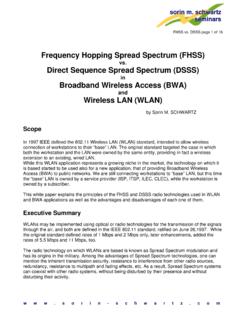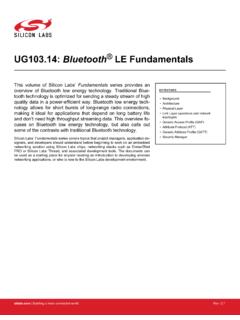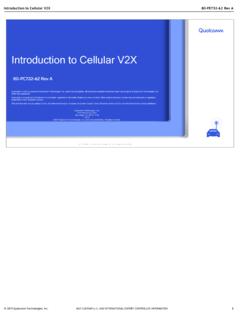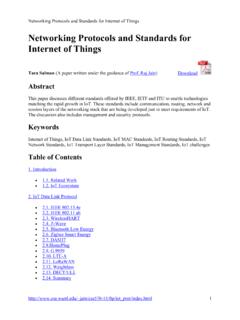Transcription of IEEE 802.11 Standards: Wi-Fi 6 and beyond
1 IEEE Standards: Wi-Fi 6 and beyondWi-Fi networks: in use today for Emergency ServicesNew Amendments: Markets, use cases and key technologies2019 October JPL WorkshopPresenter: Dorothy Stanley, IEEE Working Group Chair, At lectures, symposia, seminars, or educational courses, an individual presenting information on IEEE standards shall make it clear that his or her views should be considered the personal views of that individual rather than the formal position, explanation, or interpretation of the IEEE. IEEE-SA Standards Board Operation Manual ( )Slide 1 October 2019 IEEE systems are commonly used for emergency and disaster recovery communicationsLiberty Global Teams to Provide Free WiFiin Puerto Network Recovery Following Natural Disaster: Puerto Rico after Hurricane Maria including cellular backhaul being provided via WiFi 20192 Customized products are developed using IEEE systems for remote connectivity, disaster management, targeting developing countries.
2 Example: India Centre for development of TelematicsOctober 20193 Market demands and new technology drive IEEE innovationDemand for throughputContinuing exponential demand for throughput Most (50-80%, depending on the country) of the world s mobile data is carried on (WiFi) 6 Increased throughput in , 5 (and 6) GHz bands. Increased Support for 20 Gb/s rates in 60 GHz bandNew: Extremely High Throughput Slide 4 October 2019 Categories of Enhancements in ( Wi-Fi 6)Outdoor / Longer rangePower SavingHighDensitySpectral Efficiency & Area Throughput8x8 AP1024 QAM25% increasein data rateOFDMAE nhanced delay spread protection-long guard intervalScheduled sleep and wake times20 MHz-only clientsSpatial ReuseDL/UL MU-MIMOw/ 8 clients s8 s4 s4 s16 s4 sVariable durations per HE-LTF symbol 11axExtended range packet 11axBeaconTFNext TWTB eaconTFTFTFTWT element.
3 Implicit TWT, Next TWT, TWT Wake IntervalTWT Wake IntervalDL/ULMU DL/ULMU DL/ULMU DL/ULMU 80 MHz Capable20 MHz-only2x increasein throughputacaxUp to 20% increasein data rateLong OFDMS ymbol5 October 2019 IEEE meets the MAC/PHY requirements for 5G Indoor Hotspot test Environment defined by IMT-2020 Analysis and simulations confirm that performance of IEEE MAC/PHY meet or exceed 5G requirements for the 5G Indoor Hotspot use case Similar studies are underway for the Dense Urban test environment6 October 2019 MetricITU-R Evaluation MethodMinimum Performance1 Peak data rateAnalyticalDL/UL: 20/10 GbpsDL/ Gbps [Note 1]2 Peak spectral efficiencyAnalyticalDL/UL: 30/15 bits/s/HzDL/UL: bits/s/Hz [Note 2]3 User experienced data rateAnalytical for single band and single layer;Simulation for multi-layerNot applicable for Indoor HotspotNot applicable45thpercentile user spectral efficiencySimulationDL/UL: bits/s/HzDL/UL: bits/s/Hz [Note 3]5 Average spectral efficiencySimulationDL/UL: 9 bits/s/Hz/TRxPDL/UL: bits/s/Hz/TRxP [Note 3]6 Area traffic capacityAnalyticalDL:10 Mbit/s/m2 Required DL bandwidth = 170 MHz with 3 TRxP/site.
4 [Note 4]7 MobilitySimulationUL: bits/s/HzUL: bits/s/Hz8 BandwidthInspection100 MHz, scalable20/40/80/80+80/160 MHz9 User plane latencyAnalyticalDL/UL: 4 msDL/UL : 80 us [Note 5]Use Cases: Ultra-Short Range 8K UHD -Smart Home AR/VR and wearables Data CenterInter Rack connectivity Video / Mass-Data distribution Mobile Offloading and MBO Mobile Fronthauling Wireless Backhauling (w. multi-hop) Office Docking Fixed WirelessKey additions : SU/ MU MIMO, up to 8 spatial streams Channel bonding Channel aggregation Non-uniform constellation modulation Advanced power saving is defining next generation 60 GHz: increased throughput and rangeOctober 2019 Slide 720 Gbps+ rates are definedLicense-Exempt bands above 45 GbpsCompletion in 2020; First chipsets announced60 GHz Mesh Backhaul Wireless Use Case: Deploying Today Leading Wi-Fi and wireless network solution vendor Cambium Networksannounced today that they will be incorporating Facebook s Terragraphtechnology into a new series of Cambium Networks 60 GHz radio productscalled cnWave.
5 The news comes as Terragraphappears to be ramping up go-to-market activities with trials underway in Hungary and most recently in Malaysia. Terragraphis essentially a 60 GHz-based meshed (or multi-hop, multi-point) backhaul radio system for deployment at street level in cities. 20198 Use Cases: AR/VR 4K and 8K video streaming Remote office Cloud computing Video calling and is a new amendment that builds on October 2019 Slide 9 Extremely High Throughput (EHT)Higher throughout up to 30 GbpsSupport for low latency communicationsOperations in GHz, 5 GHz, and 6 GHz bandsTargeted completion in 2023 Indoor Location 2nd generation positioning Enhancements for Next Generation V2 XInternet of Things, Low Power applications Wake-up RadioSlide 10 October 2019 Longer RangeHigher ThroughputBackwards CompatibilityPositioningTarget Wait Time for Low power devices (11ah, 11ax)New Usage seamless Next Generation PositioningOctober 2019 Slide 11 Next Generation Positioning project is the evolutionary roadmap of accurate location (FTM)
6 Appearing first in previous revisions of the standard: Accurate indoor Navigation (sub 1m and into the < domain). Secured (authenticated and private) positioning open my car with my smartphone, position aware services (money withdrawal). Open my computer with my phone/watch. Location based link adaptation for home usages (connect to best AP). Navigate in extremely dense environments (stadia/airport scenarios). defines an evolution of for V2X is largely based on defines MAC/PHY enhancements from , ac, ax, to provide a backwards compatible next generation V2X protocol. Higher Throughput OFDM frame design Higher MCS, LDPC coding Packet aggregation Longer Range Mid-amble design Repeated transmission mechanism More robust channel coding Support for Positioning Backward Compatibility Backward compatible frame format design, Version indication12 Longer RangeHigher ThroughputBackwards CompatibilityPositioningOctober 2019 New Radio technologies are under development to meet expanding market needs and leverage new technologies Increased throughput in , 5 (and 6) GHz bands.
7 Increased efficiency. Support for 20 Gbpsin 60 GHz band Extremely High Throughput 2ndgeneration positioning features Wake up radio. Low power IoT applications. Light Communications Enhanced Broadcast Service Enhancements for Next Generation V2X Random and Changing MAC Addresses Topic Interest Group Sensing Topic Interest GroupSlide13 October 2019Wi-Fi technologies continue to be a foundation for innovative solutionsProject Owl: IBM-backed project Creates Wi-Fi Network for Natural Disasters Project Owl managed to create a live internet network across one square mile using 23 DuckLinks, communicating via the system in areas without cell reception..create a specialWi-Fi network spanning more than 100 square miles that can be used to connect victims and first responders. October 201914 Thank YouQuestionsOctober 201915 Global ReachTechnical Breadth1,300+Active Standards423,000+Members160 Countries46 TechnicalSocieties and Councils1,800 Annual Conferences4,000,000+Technical Documents200+Top-cited PeriodicalsIEEE Today at a GlanceOctober 201916 The IEEE Working Group is one of the most active WGs in 80217 October 802 Local and Metropolitan Area NetworksStandards Committee (LMSC) WG Voting Members: 300+OSI Reference ModelApplicationPresentationSessionTrans portNetworkData LinkPhysicalMediumIEEE802 Focus on link and physical layers of the network stack Leverage IETF protocols for upper Working Group.
8 Time Sensitive Networking, an enabling technology for Industry ability to carry data traffic of time-critical and/or mission-critical applications over a bridged Ethernet network shared by applications having different Quality of Service (QoS) requirements, , time and/or mission critical TSN traffic and non-TSN best effort traffic. Provides guaranteed data transport with bounded low latency, low delay variation, and extremely low data loss for time and/or mission critical achieves zero congestion loss for critical data traffic by reserving resources for critical traffic, and applying various queuing and shaping techniques. See 2019 New Radio technologies are under development to meet expanding market needs and leverage new technologies Increased throughput in , 5 (and 6) GHz bands. Increased efficiency.
9 Support for 20 Gbpsin 60 GHz band Extremely High Throughput 2ndgeneration positioning features Wake up radio. Low power IoT applications. Light Communications Enhanced Broadcast Service Enhancements for Next Generation V2X Random and Changing MAC Addresses Topic Interest Group Sensing Topic Interest GroupSlide19 October 2019 Market demands and new technology drive IEEE innovation Demand for throughput Continuing exponential demand for throughput ( , ) Most (50-80%, depending on the country) of the world s mobile data is carried on (WiFi) devices New usage models / features Dense deployments ( ), Indoor Location ( ), Automotive (IEEE , Next Gen V2X), Internet of Things ( ) Low Power applications ( ) Technical capabilities MIMO (IEEE , , ) and OFDMA ( ) 60 GHz radios ( ) Changes to regulation TV whitespaces (IEEE ), Radar detection (IEEE ), 6 GHz ( , )
10 Coexistence and radio performance rules ( , ETSI BRAN, ITU-R)Slide 20 October 2019 Indoor Hotspot: Wi-Fi todaycan meet the needs of indoor and outdoor hotspots: for a single home user .. or a whole stadium of users21 Source: Aruba/HPE, used with their permission2019: Super Bowl 53 smashes Wi-Fi record with 24 TB of traffic at Mercedes-Benz StadiumAverage Wi-Fi data use per connected fan also set a new record, with the per-fan mark of megabytes per user eclipsing last year s markof : a huge leap from the official TBseen at 2018 Super Bowl 52 in Minneapolis at Bank StadiumSource: 2019 OFDMA enables further AP customization of channel use to match client and traffic demandsIncreased efficiency for (high percentage of traffic) short data frames22 TimeTimeTarget Wake TimeSchedule Sleep and Wake Times With the Target Wake Time (TWT) feature, an AP can schedule devices to sleep for long times, depending on anticipated traffic load Devices can be scheduled to wake up individually or as a group (taking advantage of MU technologies) to quickly and efficiently exchange data before going back to sleep again The primary goal is to reduce power consumption for battery-powered devices like smartphones and IOT sensors.








